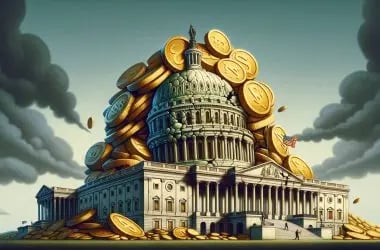Add your promotional text...
America’s Fiscal Crossroads: Debt Limits, Spending Cuts, and the Challenges Ahead
Synopsis: The U.S. narrowly avoided a government shutdown with a temporary spending bill extending through March 2025. While it addresses immediate concerns, looming fiscal challenges, including a $1.5 trillion debt limit increase and $2.5 trillion in spending cuts over the next decade, pose significant hurdles. Goldman Sachs foresees contentious negotiations and potential delays in achieving these targets.
MARKETSGLOBAL
By Alankrita Shukla
12/23/20243 min read


A Temporary Reprieve: Avoiding a Shutdown
In a move that staved off immediate crisis, Congress passed a spending extension bill that secures funding until March 14, 2025. The bill allocates $100 billion for disaster relief and $30 billion for agricultural aid.
While this measure ensures short-term stability, it leaves unresolved issues such as raising the debt limit and addressing broader fiscal imbalances.
Debt Limit Increase: A $1.5 Trillion Boost with Strings Attached
One of the most pressing challenges ahead is raising the debt limit. Although omitted from the recent bill, Republican leaders have committed to increasing the limit by $1.5 trillion in 2025. This adjustment, likely to be introduced as part of a reconciliation bill that bypasses the need for bipartisan support, is expected to extend the deadline for the next debt ceiling debate to early 2026.
However, this increase is tied to a commitment to reduce spending by $2.5 trillion over the next decade. This ambitious goal, equivalent to 0.7% of GDP, poses significant challenges in both design and execution.
The Spending Cut Conundrum
Goldman Sachs highlights the difficulties in achieving the proposed $2.5 trillion savings:
Healthcare Programs
Potential Medicaid reforms and Medicare payment adjustments could yield up to $1.7 trillion in savings.
Expiring subsidies under the Affordable Care Act may add another $300 billion over ten years.
Repealing the Inflation Reduction Act (IRA)
Theoretically, repealing the IRA could save $500 billion over a decade.
However, bipartisan support for some IRA provisions, such as electric vehicle incentives, may limit actual savings to $100 billion over ten years.
Tariff Revenues
Tariff increases could contribute, but achieving near-unanimous support for such measures remains a significant hurdle.
Goldman underscores that resistance within the Republican Party itself could further complicate these efforts. "The experience over the last few days highlights how hard it will be to get the near-unanimous support needed to pass a fiscal package along party lines," the firm notes.
Two Possible Fiscal Paths for 2025
Goldman Sachs envisions two potential strategies for addressing these fiscal challenges in 2025:
Option 1: Two-Step Reconciliation Process
This approach involves passing two separate bills:
A smaller initial bill focused on immigration reforms and the debt limit.
A larger subsequent package targeting tax cuts and broader spending adjustments.
Goldman suggests this two-step process is more likely, as it allows the incoming administration to secure quick wins on politically sensitive issues like immigration.
Option 2: A Comprehensive Fiscal Package
The alternative is a single, all-encompassing bill that addresses debt limits, tax reforms, and spending cuts simultaneously. However, this option is less probable due to the complexity and time required to negotiate such a package.
What Lies Ahead?
January 2025: The Starting Point
Republican leaders are expected to kick off the two-step fiscal strategy in January by introducing a budget resolution to facilitate reconciliation legislation.
This process will likely delay clarity on the broader fiscal package until later in 2025, creating an environment of prolonged uncertainty for markets and policymakers alike.
The Political Landscape
Partisan divisions and internal disagreements within the Republican Party are likely to dominate the fiscal policy debate. This environment could result in prolonged negotiations and potential delays in implementing key measures.
Implications for the Economy
Goldman Sachs warns that these fiscal challenges, if not resolved efficiently, could have far-reaching implications for the U.S. economy:
Short-Term Stability vs. Long-Term Risks: While the spending extension provides temporary relief, failure to address underlying fiscal issues could lead to heightened market volatility and economic uncertainty.
Impact on GDP: The proposed spending cuts, if implemented, would represent 0.7% of GDP, potentially influencing economic growth trajectories.
Market Sentiment: Prolonged fiscal uncertainty may weigh on investor confidence and market performance.
Navigating a Complex Fiscal Future
The U.S. faces a challenging fiscal road ahead, with ambitious targets for debt limit increases and spending reductions. While the recent spending extension averts an immediate crisis, achieving long-term fiscal sustainability will require navigating complex political and economic dynamics.
As Congress gears up for critical negotiations in 2025, the stakes are high. The outcome of these debates will not only shape America’s fiscal landscape but also set the tone for its economic trajectory in the coming decade.
